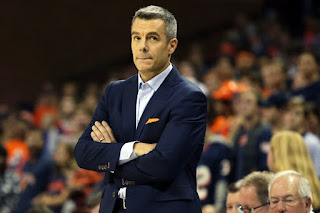The Danny Ainge System: Using Sabermetrics to rate every NBA team's top executive
Big 12 Commissioner Upbeat About Conference Future In College Football Playoff
Your browser is not supportedstatesman.Comstatesman.Com wants to ensure the best experience for all of our readers, so we built our site to take advantage of the latest technology, making it faster and easier to use.
Unfortunately, your browser is not supported. Please download one of these browsers for the best experience on statesman.Com
Paying College Football Players Could Reverse Trend Of Bowl Game Opt-outs, Boost Non-CFP Postseason
SCOTTSDALE, Ariz. (AP) — With the expanded College Football Playoff locked in through 2031, questions still remain about what the rest of the postseason will look like.
One thing is certain, there will still be bowls.
"College football cannot have a postseason that only provides 12 opportunities," Nick Carparelli, executive director of Bowl Season, the organization that advocates for bowl games, said Thursday. "That's contrary to every other NCAA sport. And the leadership of college athletics has been very clear in recent years that they want more opportunities for student athletes to compete in the postseason, not less across all sports."
Carparelli has some ideas to keep bowl games robust and relevant, including creating more freedom for games to make the most interesting matchups. Though the biggest change could come from outside the bowl system as college football moves to a more professionalized model and player compensation agreements mandate postseason participation.
The CFP expands from four to 12 teams this season. It could jump to 14 teams starting as soon as 2026. Even in a four-team system, the playoff decreased the focus on the bowls and prompted discussion about how meaningful they were.
While the dozens of bowl games played around Christmas and New Year's still draw a healthy amount of eyeballs to TVs, player opt-outs have become commonplace.
"I still believe at their core kids like playing football," said Carparelli, who was attending a Fiesta Bowl event that included Big 12 and Mountain West Conference meetings earlier this week. "They've been presented with reasons why not to in recent years. And I think that's very unfortunate for sure."
Caparelli believes the future of college football includes revenue sharing with players and possibly name, image and likeness compensation deals that set terms similar to pro sports contracts.
"As player compensation becomes the norm, at some point in time, I think it's reasonable to expect that there's going to be some obligation on the part of the student-athlete receiving the compensation to perform the duties as assigned," he said. ""In my mind, 12 regular-season games, a bowl game or playoff."
This year there will be 36 bowl games played outside the College Football Playoff, which will also include four first-round games played on campus sites.
Carparelli said he doesn't believe the bowl eligibility minimum of six victories will change. Whether there will still be a need for three dozen bowl games for the 2026 season and beyond is to be determined.
Even the bowls outside the playoff structure have contractual agreements with conferences that run concurrent to the CFP's original 12-year deal, which expires after the 2025 season. All those games are about to become free agents.
Conferences prefer to lock in numerous bowl partnerships to guarantee eligible teams a spot in the postseason.
Carparelli would like to encourage more flexibility in the bowl selection process, allowing the games the ability to make compelling matchups with the available teams — more similar to way bowls operated 30 or 40 years ago — instead of being locked into predetermined conference deals.
"It would be the conferences that would need to make that decision," he said. "Anything is possible. At the highest level, the CFP has decided that there's not going to be any certainty there outside of five conference champions to be in that system. I don't see any reason why that can't translate to the next level of bowl games."
___
Follow Ralph D. Russo at https://twitter.Com/ralphDrussoAP and listen at http://www.Appodcasts.Com
___
AP college football: https://apnews.Com/hub/college-football
Former Arizona OT Joseph Borjon Transfers To San Diego State
Former Arizona Wildcats offensive tackle Joseph Borjon, who entered the transfer portal earlier this month, announced on Monday that he's committing to San Diego State.
The 6-8, 325-pound redshirt junior was a backup tackle for the Wildcats during the 2022 and '23 seasons, after the La Puente, California, native transferred to Arizona from Mt. San Antonio College in Southern California.
Last season, Borjon appeared in six games and made three starts, including right tackle in Arizona's win over Oklahoma in the Alamo Bowl, while Jonah Savaiinaea played right guard with Raymond Pulido at left tackle in place of first-round NFL Draft pick Jordan Morgan, who opted out of the bowl. Arizona's offensive line struggled against OU's pass rushers and received its worst protection grade (52.7) of the season on Pro Football Focus.
In the second half of the Alamo Bowl, Savaiinaea moved back to right tackle and redshirt sophomore Leif Magnuson, who started in place of Pulido while he nursed an ankle injury at the start of conference play, was inserted at right guard. Arizona scored 17 points in the fourth quarter to beat the Sooners.
Before entering the transfer portal this spring, Borjon had mostly taken reps at backup tackle behind Pulido and Savaiinaea. With Borjon gone, other tackles besides Savaiinaea and Pulido include redshirt freshmen Rhino Tapa'atoutai, Tylen Gonzalez and early enrollee Matthew Lado.
The spring transfer portal closes on Tuesday.



Comments
Post a Comment